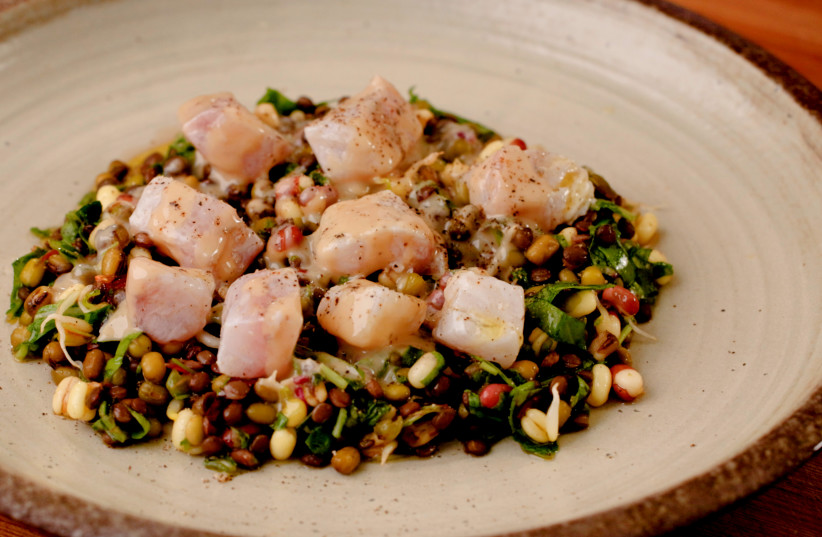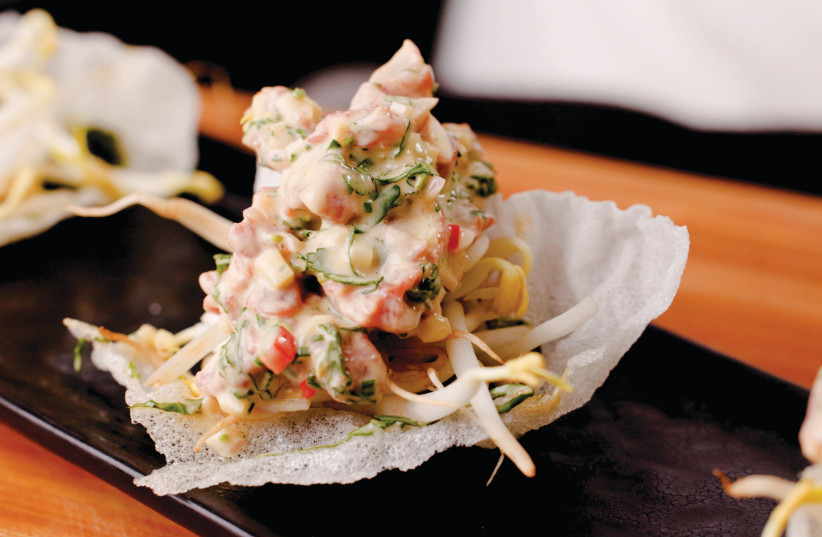I am very proud of the organic vegetable garden in my backyard. And for me, tending it is a labor of love.
We have a number of citrus trees and one special olive tree. Each year, as soon as the olives on our tree have ripened, we spread a huge tarp on the ground, then gently shake the tree. The olives that fall onto the tarp are ready to be pickled.
Next, we gather up all the olives and commence with the sorting process. First, we remove all the leaves, stones and bruised olives. Then, we wash and rinse the olives and place them in jars with herbs to pickle them. One thing I’ve never tried my hand at, though, is making olive oil.
Despite the fact that I absolutely adore having an olive tree in my garden, I’d never actually seen an olive press up close or ever walked through an olive grove.

And so, when I received a personal invitation from chef Golan Israeli to join him at his olive grove at Meshek Achiya in Shiloh, to watch with my own eyes how olives are harvested, crushed and made into oil, I jumped at the opportunity.
Moreover, Golan agreed to share with me a few of his favorite recipes that include olive oil.
The drive up to Shiloh, which is located in Samaria, took me through some of the most beautiful areas of Israel and reminded me a bit of Tuscany. This was the first time I’d ever driven through Samaria, and I loved looking out at the pristine landscapes as I navigated the hills.
Upon arriving in Shiloh, I was met by Yedidya Maman, the director of Meshek Achiya’s agriculture department; and Roi Karmi, the company’s VP of marketing, who is a professional taster and judge in olive oil competitions. He explained to me in detail all about the types of olives and combinations made between different varieties.
Israelis, on average, consume about two liters of olive oil every year. In recent years, olive oil has become an indispensable ingredient used in the kitchen, especially for making stews and pastries, since it is considered to be higher quality, healthier and tastier than other oils.
Many factors affect the taste of olive oil, as in the case of wines, such as where the olives are grown, the climate and the type of soil (aka terroir – the set of environmental conditions).
The olives that are processed in the olive press at Meshek Achiya are grown in a number of different locations around Israel. Achiya produces over 850 tons of olive oil each year from the Barnea, Koroneiki, Picual, Syrian and Arbequina varieties. Olive oil made from Syrian and Barnea varieties are the most popular. However, in recent years Israelis have become more open to sweeter olive oils, which can be used with a wider variety of foods.
Fun facts about olives
- Olives have three stages of ripeness: green, half-green/half-purple, and black.
- Green olives are the best for pickling, since they have the strongest flavor.
- Half-green/half-purple olives are the best for producing olive oil.
- The darker the olive, the sweeter the oil will be.
- Each type of olive is harvested separately.
- Olives of a single variety that are at different stages of ripeness can be blended together, but olives of one variety cannot be blended with olives of a different variety.
Popular olive varieties
- Barnea is an Israeli variety, with an elongated shape and a mild taste. It is herbaceous, and its degree of spiciness is low. It is harvested in late November-early December.
- Picual, which is a Spanish variety, is a round and fleshy variety. Its shape is round, and its tip looks like a mountain. The word pico in Spanish means “the peak of a mountain,” hence its name. Picual has a citrusy smell and a powerful taste. It is harvested in November-December.
- Arbequina is a Spanish variety that grows on trees with a wilder shape. These olives are elliptical in shape and smaller than Barnea. Its taste is fruity and sweet. Its harvest is usually in October. This year, due to climate changes, the harvest took place in November.
- Koroneiki is a Greek variety of small olives that look like marbles and have a special fruity flavor. It is usually harvested at the end of the olive harvesting season.
- Syrian is a variety that comes from Tyre in Lebanon. The oil has a dominant flavor and a strong character. It has become a popular Israeli variety, along with the Nabali variety, which hails from the city of Nablus.
PASTA SALAD WITH TOMATOES, OLIVES AND HERBS
Makes 10 servings.
- 1 medium shallot, finely chopped
- 50 gr. Kalamata olives, pitted and chopped
- 1 bunch (about 20 large leaves) basil leaves
- 5 anchovy fillets in oil
- 100 ml. Syrian olive oil
- 100 gr. dried tomatoes in oil, thinly chopped
- 1 package (500 gr.) fusilli pasta
- 10 cloves garlic confit (homemade or store-bought)
- Black pepper, to taste
Serving suggestions:
- 1 red onion, sliced into thin rings
- 50 gr. roasted pine nuts
- Syrian olive oil for drizzling on top
Use a mortar and pestle to grind the shallot, basil leaves, Kalamata olives and anchovies together. While crushing them, add the oil and continue until all the ingredients are mixed well. Add the dried tomatoes and stir.
Boil the pasta according to package directions, then drain and transfer to a large bowl. Add the garlic confit and the ground mixture to the pasta. Stir and season with pepper.
Pour the pasta onto a serving platter and garnish with onion rings and pine nuts. Drizzle olive oil on top and serve.
Level of difficulty: Easy
Time: 20 minutes
Status: Parve

MEDITERRANEAN FISH WITH MUNG BEANS AND BELUGA LENTILS
Makes 5 servings.
- 200 gr. mung beans
- 200 gr. beluga lentils
- Juice from 2 medium-ripe tomatoes
- Juice from 2 large lemons
- 7 Tbsp. Picual extra virgin olive oil
- Kosher salt and black pepper
- 500 gr. any type of white fish like greater amberjack, cut into small pieces that are 1 cm. thick
- 50 gr. Picual extra virgin olive oil
- Juice from ½ lemon
- 1 tsp. salt
- ½ tsp. black pepper
- 1 bunch arugula lettuce
- 1 bunch cilantro
- 1 bunch mint
Drizzle
- 6 Tbsp. raw tehina
- Picual extra virgin olive oil
Soak the mung beans and beluga lentils, each in separate bowls, for 1 hour. Drain them and transfer them to 2 separate medium pots. Cover both with water and cook each one until they have just softened (be careful not to overcook them). Drain.
To prepare the salad dressing: Mix together the tomato and lemon juices, olive oil, salt and pepper.
Place the pieces of fish in a large bowl, then add the olive oil, lemon juice, salt and pepper. Mix well, then set aside to marinate.
In the meantime, chop all the herbs or slice thinly and mix with the beans and lentils. Pour the dressing on top and mix. Transfer to a serving platter or individual plates. Add the fish pieces on top, then drizzle with tehina and olive oil. Serve immediately.
Level of difficulty: Easy
Time: 1 hour, plus marinating time
Status: Parve

ASIAN TARTARE ON RICE CRACKERS
Makes 5 servings.
- 500 gr. fresh fillet steak, cut into 1-cm. cubes
- 30 gr. fresh ginger, finely chopped
- 50 gr. shallot onions, finely chopped
- 1 bunch chives, finely chopped
- 2 Tbsp. mayonnaise
- 2 Tbsp. spicy chili peppers, finely chopped
- 1 Tbsp. sesame oil
- 2 Tbsp. soy sauce
- 3 Tbsp. Arbequina olive oil
Pesto
- 1 bunch of cilantro
- 50 gr. peanuts, roasted and lightly salted
- 2 garlic cloves
- 7 Tbsp. Arbequina olive oil
Serving suggestion
- 10 sheets rice paper
- Package bean sprouts, soaked in ice water for 10 minutes, then drained
- 50 gr. roasted sesame seeds
Add the beef chunks to a bowl, then add the ginger, onion and chives. Mix well, then add the mayonnaise and chopped chili peppers. Mix again, then add the sesame oil, soy sauce, Arbequina olive oil and mix well.
Next, take a sheet of rice paper and deep-fry it in oil for 2 seconds, then remove it immediately. The rice sheet will shrivel up and become wonderfully crispy. Cook the rest of the rice sheets in the same fashion.
Process all of the pesto ingredients in a food processor until smooth. Taste and adjust seasoning. Spread a little pesto on each fried rice shell, then top with bean sprouts. Place pieces of beef on top, then sprinkle with roasted sesame seeds. Serve immediately.
Level of difficulty: Easy-medium
Time: 30 minutes
Status: Meat
Thanks to Achiya (www.m-achiya.co.il) and chef Golan Israeli (golanisraeli on Instagram) for their hospitality.
Translated by Hannah Hochner.
